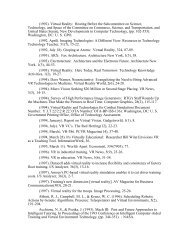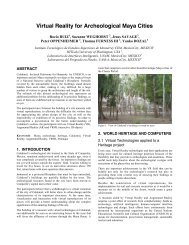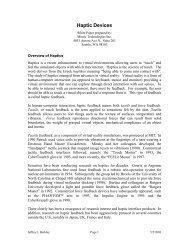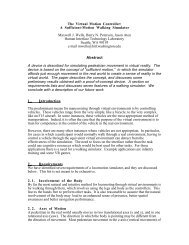A Calculus of Number Based on Spatial Forms - University of ...
A Calculus of Number Based on Spatial Forms - University of ...
A Calculus of Number Based on Spatial Forms - University of ...
Create successful ePaper yourself
Turn your PDF publications into a flip-book with our unique Google optimized e-Paper software.
49<br />
Table 6.1: Transcendentals in the <str<strong>on</strong>g>Calculus</str<strong>on</strong>g>.<br />
Transcendental Standard Boundary<br />
J i []<br />
p<br />
i<br />
,1 (([J]))<br />
3:1415 ::: (J[J]([J]))<br />
e 2:7183 ::: ()<br />
From J and i, a radian interpretati<strong>on</strong> <str<strong>on</strong>g>of</str<strong>on</strong>g> can be algebraically c<strong>on</strong>structed.<br />
= ,1 i i<br />
= ([][(([J]))][J])<br />
= (J[J]([J]))<br />
This c<strong>on</strong>structi<strong>on</strong> <str<strong>on</strong>g>of</str<strong>on</strong>g> treats it not as a real number but as the radian unit. Its<br />
semantic value comes out <str<strong>on</strong>g>of</str<strong>on</strong>g> this algebraic c<strong>on</strong>structi<strong>on</strong> and has no relati<strong>on</strong> to its<br />
numerical value <str<strong>on</strong>g>of</str<strong>on</strong>g> =3:14159 :::.<br />
The numerical values <str<strong>on</strong>g>of</str<strong>on</strong>g> e and in standard mathematics are based <strong>on</strong> criteria<br />
independent <str<strong>on</strong>g>of</str<strong>on</strong>g> the manipulati<strong>on</strong>s used here (e.g. geometry) and are not essential<br />
to the algebraic behavior <str<strong>on</strong>g>of</str<strong>on</strong>g> the transcendentals. In the calculus, they are devoid <str<strong>on</strong>g>of</str<strong>on</strong>g><br />
numerical value and remain incommensurable with other quantities. The boundary<br />
representati<strong>on</strong>s <str<strong>on</strong>g>of</str<strong>on</strong>g> these basic transcendental values are given in Table 6.1.<br />
6.5.3 Trig<strong>on</strong>ometric Functi<strong>on</strong>s<br />
In the calculus, trig<strong>on</strong>ometric functi<strong>on</strong>s can be computed symbolically using the three<br />
boundary rules. The functi<strong>on</strong> for cosine in standard and boundary forms appears as:<br />
cos x = eix + e ,ix<br />
2<br />
versus<br />
cosx=([(([x]([J])))(([]([J])))])<br />
The cosine functi<strong>on</strong> behaves as expected, reducing to real results. For instance,<br />
cos = ,1. Although the derivati<strong>on</strong> can be lengthy and complicated, it is based<br />
entirely <strong>on</strong> the three axioms and the theorems that follow from them. Accordingly,<br />
trig<strong>on</strong>ometric formulas can be derived from these axioms.












